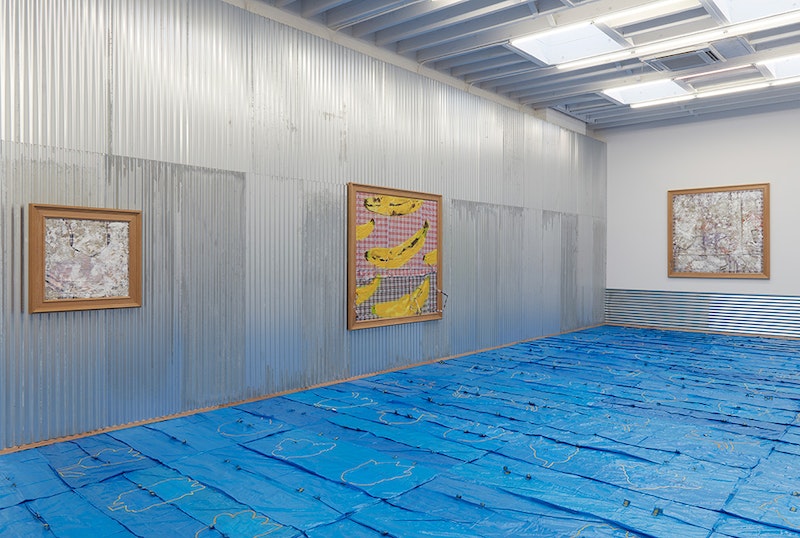February 1, 2023
Download as PDF
View on The Brooklyn Rail

Installation view: Oh, Sandy? Sandy, Sandy, Karma, New York, 2023. Courtesy Karma, New York.
Alvaro Barrington is all over the place. Literally. He’s out east, at Karma on East 2nd Street and up north at Anton Kern on 55th Street. And if these geographic extremes of the Manhattan art world aren’t enough, there’s the artist himself: his parents were from Grenada and Haiti, while he was born in Venezuela, brought up at least partly in Brooklyn, and now lives and works in London. Holding all this together is a single personality, Alvaro Barrington, whose work is highly autobiographical—though the very term in his case is fraught with ambiguity because here the autobiographical impulse expresses itself in multivalent fragments rather than a coherent narrative. This may be confirmed by the invaluable Oh, Sandy? Sandy, Sandy: Barrington’s Notes volume that accompanies both shows, a series of visual footnotes rather than a diary.
The first thing to notice is that this two-venue presentation is actually two related but independent shows whose titles derive from the same source, the film Grease, made in 1978, five years before Barrington was born. Images from the film, especially gestural portraits of Travolta, dominate the show at Anton Kern, but mixed in here is Hurricane Sandy, which devastated both the Caribbean and New York in 2012. These two Sandys, seemingly unrelated, are connected in Barrington’s memory and are translated into the various pieces of his autobiographical jigsaw puzzle.
We may never know what significance either Grease or the hurricane carries in Barrington’s psyche, but we can at least propose some ideas. First would be loss, expressed in the mawkish song Travolta warbles when he thinks Sandy is gone forever. The second would be hope. Again, Travolta hopes they may be someday reunited. The hurricane reinforces both of these ideas: human and material loss, the hope involved in rebuilding. And the first piece that summarizes all of this hangs in Karma’s front window, in the form of a sculpture that echoes the ubiquitous rollup gates that protect shops in New York’s lower east side. Of course, this rollup gate doesn’t roll, just as the chains above it hoist nothing. The gate becomes a species of Minimalist sculpture that parodies Minimalism by isolating a fragment of a utilitarian object (the gate) and declaring it sculpture. But there is more.
The undulating segments of the faux rollup gate, concave in some cases, convex in others, suggest waves of water, and the blue plastic tarpaulin on the gallery floor recalls the days of recovery after the hurricane. So Sandy is never far away, but there are human waves as well: the waves of immigrants who have washed up on the shores of the Lower East Side. Barrington, a part of these waves himself, locates the immigrant experience in various images. First, cloth, the cheap plaid used to make clothing and shopping bags. This fabric will itself undergo a metamorphosis when famous designers repurpose it to create high fashion bags sold for outrageous prices. The fabric in two collages on the north and south walls of the main Karma viewing room also become maps, topographic representations of reality, pictures to help you know where you are and where you were. But memory, clearly one of Barrington’s great tools, is also here in the form of a painted banana, a memory simultaneously of the tropics and of exploitation.
Karma’s rear viewing room is dominated by segments of rollup gate. Here we must deal with the multiple identities of these metal works: barriers, waves, and secret places the immigrant must penetrate, possess, and transform into his own brave new world. These various meanings carry us to Anton Kern Gallery, where the rollup gate achieves high elegance. The Kern presentation takes us back to Grease because so many of the paintings on the second floor are John Travolta’s character in expressionistic style, all hung in bizarre, complex frames themselves festooned with floral shapes. The curious dialectic of hot-rodders and virgins in the movie translates here into three works linked by the title Gated Community. First, the rollup gates here in the Kern space really do tell us to stay out and block our view of the rear of the gallery. Then we encounter the depiction of luxury sneakers and, ultimately, the sterility of the utopian California of Grease, where everything is beautiful and nothing is real.
Finally, Barrington’s Gated Community, The Last Reclining Woman, NYC 2023 (2023) magnificently summarizes the free association of memories and immediate perceptions that define his work in both venues. First, the material: “oil on Hermès yak woolen blanket in steel structure.” The luxury item now itself repurposed into art, but an art that transcends the ironic or parodic manipulation of fashion. The “last reclining woman” makes us wonder who the first might be. Inevitably, Manet’s Olympia (1863) comes to mind with its audaciously posed prostitute challenging us with her brash sexuality. Barrington tosses that form of eroticism, and the male gaze that perpetrates it, out the window. His reclining woman, a vast, androgynous, faceless figure, draped in a spangled robe is superb, but only as art—she is ultimately lifeless. Alvaro Barrington’s deployment of autobiographical fragments in both galleries effectively shows the full panoply of how art is conceived in 2023: all materials are fair game; all personal memories are fair game; all social concerns are fair game. This is art because Alvaro Barrington says it’s art.



